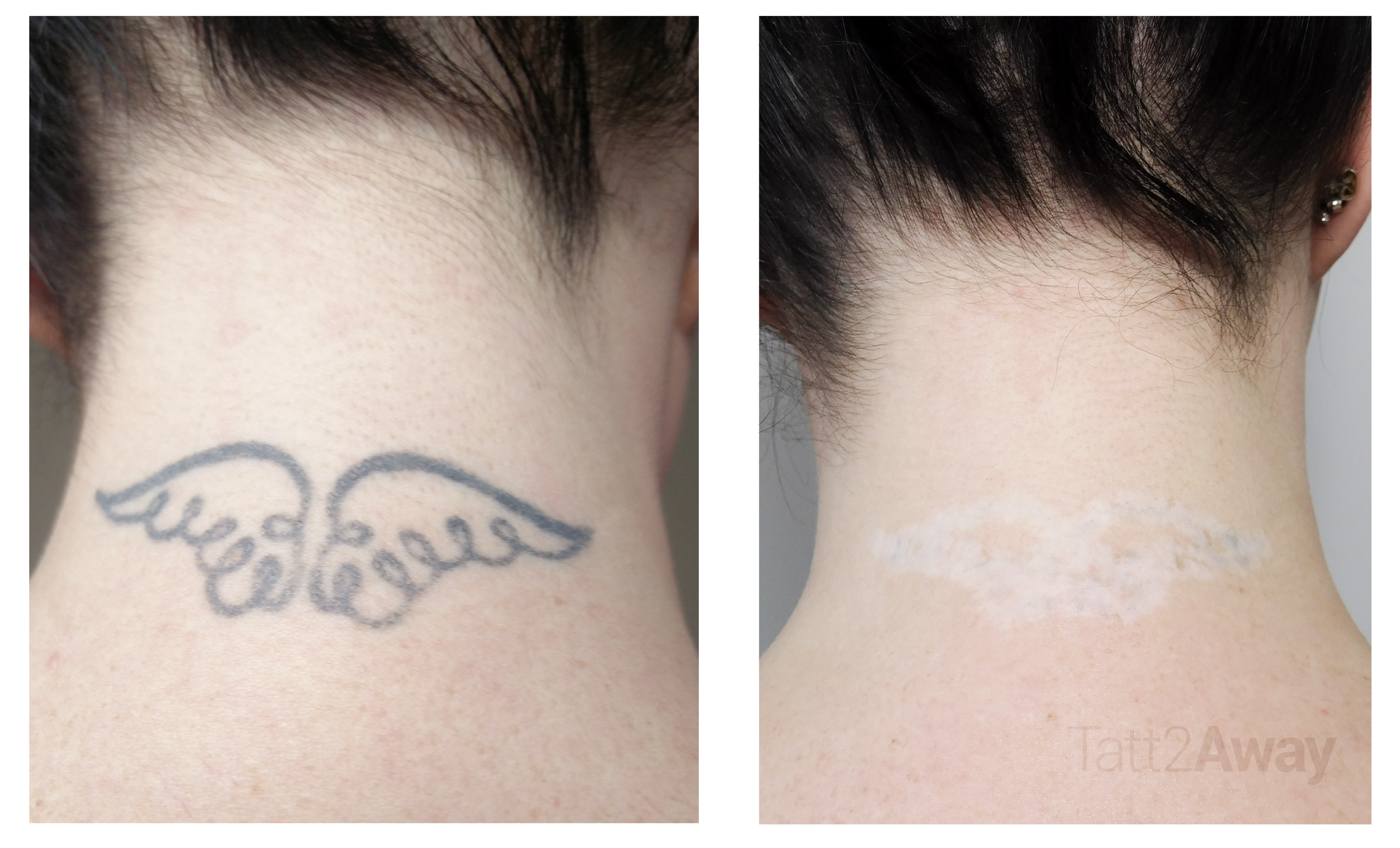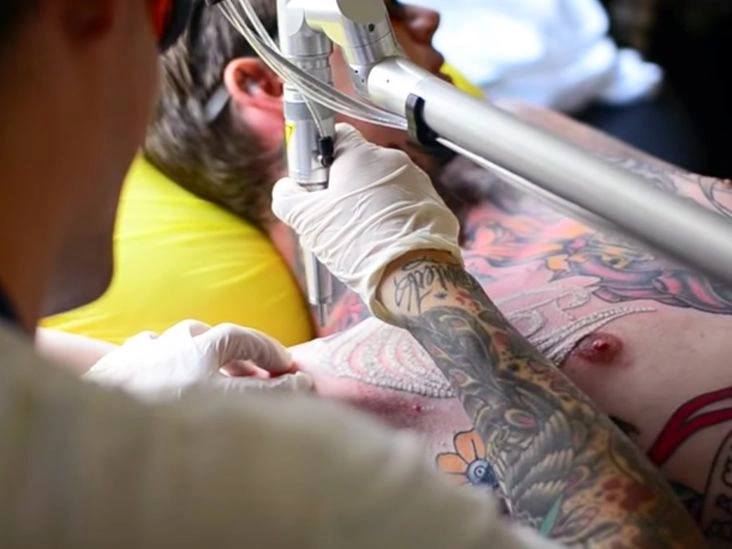Tattoos are a widespread form of self-expression but are generally permanent. The price and success of removing a tattoo depend on the technique used, and also determine how long you might feel pain or discomfort afterward.
about having ink removed? There are several approaches to consider:
- laser removal
- surgical excision
- dermabrasion
Tattoo removal usually produces results, though certain tattoos are more challenging to erase than others. For example, older tattoos and stick-and-poke designs are typically easier to eliminate than recent work.
Certain pigment colors are also simpler to remove. These often include:
- black
- brown
- dark blue
- green
Larger, brightly colored tattoos typically take more time and money to remove compared with smaller, less vibrant designs.
Because of potential side effects, tattoo removal may be more complicated if you have:
- darker skin tones
- an existing skin condition, such as eczema
- a medical issue that affects the skin, like herpes
That said, these factors do not necessarily prevent removal; they may simply mean you need to spend more time finding the safest and most effective method for you.
Types of tattoo removal
When weighing tattoo removal choices, consider several elements, including:
- cost
- risk of scarring
- effectiveness
- time required
These considerations largely depend on the tattoo’s size, intricacy, and condition, as well as your skin type.
Below is a brief comparison of common tattoo removal methods, followed by detailed descriptions of each approach.
MethodAverage costSessionsEffectivenessScarring risk
Laser removal$463 per session, according to the American Society for Aesthetic Plastic Surgerytattoo will be significantly lighter, but may not completely disappearlow, with proper aftercare
Surgical removal$200-$1,500, based on anecdotal reports1, though larger tattoos may require moretattoo will be completely removedhigh
Dermabrasionseveral hundred to thousands of dollars, according to the American Society for Dermatologic Surgery1varies from person to personvaries from person to person
Laser removal
Many professionals regard laser removal as the most effective and economical technique for removing tattoos. Often, lasers do not completely erase a tattoo; instead, they substantially fade it so it becomes much less noticeable.
Most modern removals use a Q-switched laser, which emits energy in a rapid, intense pulse. This burst of energy heats the ink in the skin, breaking it down. Several sessions over weeks or months are usually necessary to achieve desired results. Older or simpler tattoos need fewer treatments; newer or more detailed tattoos require more sessions.

If your skin tone is darker, you may prefer the Q-switched Nd:YAG laser, as it is less likely than older Q-switched models to alter darker skin pigmentation.
On average, it takes about to remove a tattoo with laser treatment. Sessions are typically spaced 6 to 8 weeks apart for optimal healing and results.
After each appointment, follow any aftercare directions provided. Usually this includes applying an antibacterial ointment for a few days to support healing and reduce infection risk. Replace the dressing every time you reapply the ointment.
For at least the next 2 weeks:
- Keep the treated area clean and dry.
- Avoid tight clothing.
- Keep the area out of direct sunlight.
- Do not pick at scabs or blisters that may develop.
Laser removal generally poses a lower scarring risk than other methods, but avoid picking at the healing area, as this increases the chance of scars.
Surgical removal
Surgical removal, also called excision, involves cutting out the tattooed skin and sewing the remaining edges together. It is the most invasive option but the only method that guarantees complete removal.
It can be less costly than laser treatments, but it always leaves a scar. For this reason, it’s usually chosen for smaller tattoos.
Excision is typically performed in a plastic surgeon’s office. A local anesthetic numbs the area, after which the surgeon uses a scalpel to excise the tattooed skin and stitches the wound closed. The operation can take a couple of hours depending on the tattoo’s size.
Recovery takes several weeks. During this period you should use the prescribed or recommended ointment for a few days to aid healing and reduce infection risk. Keep the area clean and protected from the sun for at least 2 weeks and follow your surgeon’s aftercare guidelines.
Dermabrasion
Dermabrasion uses a high-speed sanding tool to remove the top layers of skin so the ink can escape. Its outcomes vary greatly between individuals, which makes it a less favored option.
Dermabrasion may be unsuitable if you have very sensitive skin or conditions like eczema. If you’re on blood thinners, you might face increased bleeding, bruising, and pigment changes after the procedure. People with darker skin tones may also have a higher chance of color changes in the treated area.
In a typical dermabrasion session, a local anesthetic is given to reduce discomfort. A rotating abrasive instrument sands away upper skin layers, allowing tattoo pigment to leach out.
This is often completed in a single session at a cosmetic surgeon’s office. Procedure length varies by tattoo size and color range; larger, multicolored designs may take over an hour.
The treated area will likely feel raw and painful for several days afterward.
Complete recovery can take 2 to 3 weeks. Any pinkness or discoloration usually fades within 8 to 12 weeks.
During recovery, your clinician may advise you to:
- Apply an ointment to prevent infection.
- Avoid direct sunlight for 3 to 6 months post-procedure.
- Use sunscreen on the area whenever you’re outdoors.
- Avoid tight clothing over the site until it heals.
- Refrain from soaking the area in water while it heals.
Some patients develop scarring after dermabrasion. You can lower this risk by:
- using prescribed ointments
- wearing sunscreen
- avoiding sun exposure
- applying anti-scar oils and creams once the site is fully healed
Possible side effects of dermabrasion include:
- skin color changes, such as lightening, darkening, or patchiness
- infection
- redness, swelling, and bleeding
- scarring
To minimize complications, follow your clinician’s aftercare guidance and ensure the practitioner is properly licensed and well-reviewed.
What about home treatments?
Tattoo removal creams and chemical peels are the easiest to obtain and least expensive choices. They remain popular mainly because they’re cheap and accessible—but there’s little solid evidence they’re effective.
At best, anecdotal reports suggest they may slightly lighten a tattoo. At worst, they can cause serious skin damage.
Because of a high risk of irritation and allergic reactions, experts generally advise against using DIY tattoo removal creams.
Covering it up
If you don’t need to be tattoo-free, a cover-up tattoo might be worth considering.
A cover-up can be an affordable and quick way to mask an existing tattoo. This option suits people who dislike their current design but are open to getting a new tattoo.
A tattoo artist can collaborate with you to design a piece that conceals the old ink. This often means using bolder lines, heavier shading, or creative shapes. Many artists excel at crafting new designs to hide unwanted tattoos.
Once you approve a design, the artist will apply the cover-up in the same manner as the original tattoo.
Finding a specialist
No matter which removal method you select, choosing a qualified professional is crucial for safety and outcomes.
Begin by consulting a licensed dermatologist, preferably one experienced in cosmetic procedures. They can recommend the best approach for your situation and, if necessary, refer you to a surgeon or other specialist.
In the United States, the American Academy of Dermatology’s finder tool can help you locate dermatologists nearby.
Before and after pictures
Below are examples of typical before-and-after results you might expect from laser removal; consult your provider for images specific to the device and technique they use.

Bottom line
Tattoos are a common but often permanent body art choice. For those wanting to remove a tattoo, multiple options exist.
Removal techniques differ in price, success rate, and recovery time. Understanding these options will help you decide which approach best fits your needs and budget.


















Leave a Reply
You must be logged in to post a comment.